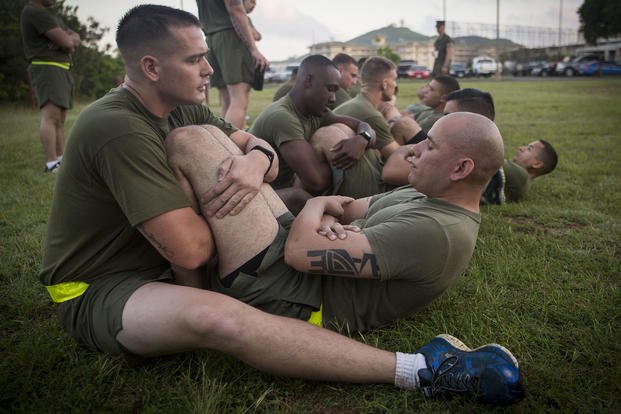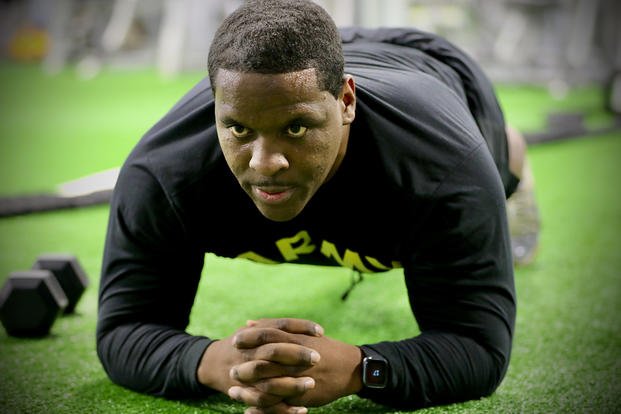If you are seeking a job in the military or law-enforcement professions, you likely will see an entrance exam that requires you to score well in sit-ups, curl-ups or crunches. All are abdominal exercises with different hand placements that test core strength and endurance and can be a challenging exercise to improve if you are not getting your repetitions in each week.
Here is an email from someone who has improved in push-ups and pull-ups but needs help with the last PT element of the Air Force physical ability and stamina test (PAST) for pararescue jumpers (PJ) and combat controllers (CCT):
"Stew, I have used your pull-up and push-up push plans and actually increased my push-ups from 50 to 88 and my pull-ups from 12 to 20 in just two weeks. Thanks! I have neglected my sit-ups, however (62 in 2 min); and need some ideas on the quickest way to increase my reps for the AF PJ two-minute PAST test for sit-ups. Do you have a "Sit-up Push Plan" like your pull/push plans? I am trying to get my sit-ups to 85--100 for the PAST."
Yes, I have been working on a sit-up overload plan to help create a better foundation to increase sit-ups by 50%-75% in 14 days. It is a little different than the Pull-up/Push-up Plan, where you take your current maximum and multiply by five for 10 straight days. Add in three rest days and test on day 14 for recovery from the overload and max out into a new level of scoring.
New Sit-up Push Program
The new sit-up push program is designed like this:
1. Mark your current maximum score for your test (62 in two minutes). Do the types of exercises for which you will be tested:
- Sit-ups: Hands behind head, with elbows touching knees
- Curl-ups: Hands crossed on chest, with elbows touching knees
- Crunches: Hands crossed on chest, with elbow touching lower thighs.
Note: If your sit-up test is only one minute, the process is the same, but your pace can be faster than in the two-minute test.

2. Take your max score and multiply by three (62 x 3 = 186) and do this number (or rounded up to the nearest 10) for 10 straight days.
3. Days 1-4: Do 186 sit-ups in 30-second paced sets, but shoot for 20-25 sit-ups in 30 seconds, so for days 1-4, you will do 186 sit-ups in timed sets of 30 seconds for four consecutive days. Your goal is to get 20-25 sit-ups in that time, so for this workout, you will do roughly 8-9 sets of 20-25 sit-ups in 30 seconds. Spread these 30-second sets throughout your existing workout, however you desire. I like to "rest with abs" between sets of pull-ups, weighted exercises or even running or swimming intervals.
* Note if you are having trouble keeping the goal pace for 30 seconds. Try it for 15 seconds and shoot for quick, timed sets of 10-12 repetitions for 15 seconds. The first 15-20 seconds of a two-minute sit-up test is where people start off too fast, so it is a good idea to practice the start of the test regularly.
4. Days 5-8: You change the timed sets and shoot for 40-50 sit-ups in one-minute sets. Do 186 sit-ups in one-minute sets, with a goal of 40-50 sit-ups per minute. This should take you 4-5 sets done throughout your workout for four days in a row.
5. Days 9-10: You change the timed sets to two minutes, focused on the same pace as above; 186 sit-ups should be completed in 2-3 sets for two consecutive days.
6. Lower-back strength: Just working the front side of the body is where many go wrong. For every sit-up repetition you do in your daily workout, you have to get in the plank pose for the same number of seconds (186 seconds or three minutes). Somewhere in your daily workouts for Days 1-10, you have to complete a total of three minutes in the plank pose.

7. Stretch the hip flexors, thighs, lower back and stomach after each day of the 10-day sit-ups program.
8. Days 11-13: It's time to recover. Take three days off from any abdominal exercises. You can still run, swim, lift and/or PT but skip ab exercises for these three days.
9. Day 14 (Test Day): Give yourself a one- to two-minute test (whichever your test requires) and focus on the goal pace you mastered. When you do your sit-ups, practice exerting on the "up" movement of the sit-up and letting gravity take you back to the ground. No need to waste your stomach muscles on letting yourself down softly on the floor. Just fall back, relaxing the abs for a second.
Where most people go wrong on two-minute timed sit-ups tests is that they start off too fast in the first 30 seconds and usually cannot match their reps in the next 1:30. So if your goal is 80-100 sit-ups in two minutes, you need a pace of 20-25 in 30 seconds, 40-50 in one minute, 60-75 in 1:30 and 80-100 in two minutes. This takes practice at not just mastering the goal pace, but building up your endurance in order to maintain the pace for longer than you previously could.
So in a nutshell, you will get better at sit-ups tests by taking more of them and increasing your endurance by increasing your sit-ups volume -- but at your goal pace for sit-ups. In the future, once you master the 100 reps in two-minute pace, you can do more sit-ups every other day, but focus on one sit-up per second to help you maintain a pace of 100-120 sit-ups in two minutes.
- Note whether your sit-up test is the one-minute test. Start off at a goal pace of 40-50 in one minute and build up to one per second or faster to get the above-average score of 60+ in one minute.
- Remember: Do not forget to work the lower back to balance out all of the extra abdominal work you are doing. If you neglect the back of your torso, you will likely suffer a lower-back injury, regardless how many sit-ups you are doing daily.
Stew Smith is a former Navy SEAL and fitness author certified as a Strength and Conditioning Specialist (CSCS) with the National Strength and Conditioning Association. Visit his Fitness eBook store if you're looking to start a workout program to create a healthy lifestyle. Send your fitness questions to stew@stewsmith.com.
Want to Learn More About Military Life?
Whether you're thinking of joining the military, looking for fitness and basic training tips, or keeping up with military life and benefits, Military.com has you covered. Subscribe to Military.com to have military news, updates and resources delivered directly to your inbox.



















